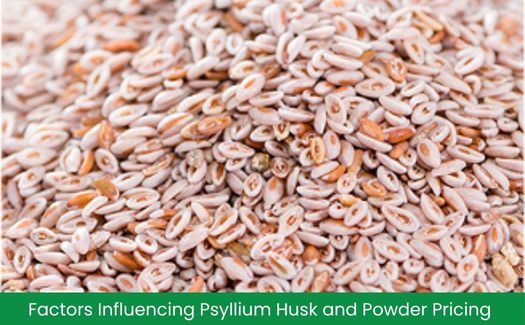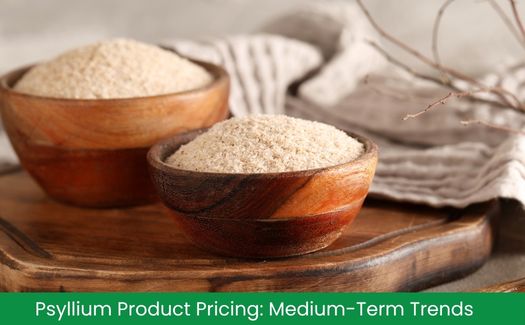Introduction to Psyllium Products
Psyllium is the common name for the soluble-fiber–rich husk obtained from the seeds of Plantago ovata. Commercially, it appears in multiple forms: psyllium seeds (whole), psyllium husk (dehusked outer coat), psyllium husk powder (finely milled husk), and psyllium kha kha powder (by-product fraction from husk processing used in specific industrial or feed applications). These forms serve diverse markets—human nutrition, bakery, nutraceuticals, pharma, pet food, and functional beverage—each with its own specification and price sensitivity.
Common synonyms and market terminology include Isabgol, ispaghula, Indian psyllium, and Plantago ovata. Understanding how prices move across these variants matters because procurement decisions (what form, which grade, when to buy, and how to pack) can change your cost-in-use dramatically. Psyllium is strongly tied to agricultural cycles in India (the primary producer), so prices react to acreage, weather, export demand, and logistics. A clear view of these dynamics helps buyers hedge risk, set reliable sell prices, and avoid stockouts during spikes.
Psyllium Product Categories and Market Segmentation
Psyllium Seeds
Seeds are the upstream raw material. Their price reflects field yields, cleaning losses, moisture, and impurity levels. Premium, well-cleaned seed lots fetch higher rates but reduce downstream wastage during dehusking. Because seed accounts for a large share of the cost stack in husk and powder, even small changes in seed rates can ripple through finished-good pricing.
Psyllium Husk
Husk is produced by dehusking and separating the outer coat from the seed. Extraction efficiency, breakage, and whiteness/purity (often graded visually) influence cost. Whole husk commands more than partially broken or low-whiteness lots. Food/pharma buyers tend to pay premiums for consistent color, low microbial counts, and clean sensory.
Psyllium Husk Powder / Kha Kha Powder
Husk powder is milled to specific fineness (mesh sizes) for beverages, capsules, and bakery. Finer, uniform powders cost more due to extra milling and sieving and because they hydrate faster and disperse better. Kha kha powder is a lower-value fraction produced during processing and is priced differently based on its fiber and impurity profile. Packaging (bulk sacks vs consumer packs with sachet lines, nitrogen flushing, and retail branding) adds further segmentation and price differentiation.

Key Factors Affecting Psyllium Prices
Raw Material Supply
Availability of psyllium seeds sets the baseline. When seed arrivals to mandis are strong and carryover stocks are healthy, prices soften; tight arrivals push rates up. While India dominates supply, any incremental production in Iran or Afghanistan can subtly affect sentiment, though volumes are typically far smaller than India’s.
Agricultural and Climatic Conditions
Weather drives acreage and yields. Timely winter sowing and benign temperatures improve pod set and fiber quality; unseasonal rain, frost, or heat waves hurt yields and can raise microbial risks, which translates to higher processing costs or downgraded lots. Seasonal patterns also matter: pre-harvest speculation and post-harvest selling cause typical Q1–Q2 price movements.
Processing and Manufacturing Costs
Dehusking efficiency, cleaning, grading, and milling are energy and labor intensive. Higher power tariffs, wage increases, or downtime (maintenance, fuel shortages) show up in ex-factory prices. Plants that invest in better separators and low-temperature milling preserve color and functionality—adding value and justifying a premium.
Product Quality and Grade
White, clean husk with high purity and low speck count commands more. For powder, mesh uniformity, hydration speed, and low grit are priced higher. Food and pharma buyers often require validated micro-reduction (e.g., steam), which adds cost but unlocks broader markets. Kha kha powder, with its different composition, trades at a discount and follows its own demand curve.
Market Demand Across Industries
Food and bakery (fiber enrichment, gluten-free texture), nutraceuticals (capsule/powder supplements), and pharma (bulk-forming laxatives) provide steady base demand. Spikes in health awareness (e.g., fiber and heart health trends) can tighten supply quickly. Domestic demand in India versus export demand balance also sways prices; strong export bookings raise FOB rates and tighten local availability.
Packaging and Branding
Bulk 25-kg sacks vs consumer packs with retail branding, sachets, and QA documentation have different cost structures. Retail SKUs carry packaging materials, filling line costs, and marketing margins. Buyers must compare landed cost per functional dose, not just per kilogram, especially when powders of different fineness hydrate differently.
Supply Chain and Logistics
Inland freight from growing belts to processing hubs, container availability, port congestion, and ocean rates affect CIF/FOB spreads. Storage conditions (humidity control) require better liners and warehousing—costs that are passed through or absorbed depending on contract terms. Export-import duties, testing requirements, and documentation (ETO-free declarations, micro reports) add to transactional costs.
Market Speculation and Seasonal Trends
Hoarding in tight years, changes in export policies, or sudden retail runs can move prices quickly. Traders watch mandi arrivals, futures sentiment in related agri markets, and inventory reports; such behavior can amplify short-term swings beyond pure fundamentals.
Regional and International Price Influences
India’s Rajasthan and Gujarat are the heartlands of psyllium cultivation and processing; their weather, labor conditions, and policy environment set the global tone. Limited contributions may come from neighboring countries, but the global market largely keys off Indian harvests and export pace. Currency matters: a stronger USD against INR can make Indian exports more competitive, supporting FOB prices even when local seed is steady. Conversely, freight inflation or stricter import testing in destination markets (EU/US) can widen landed premiums. Global health trends—fiber fortification, low-carb bakery, gut-health supplements—add a secular uplift to demand, gradually raising the price floor over time.
Future Pricing Outlook for Psyllium Products
A medium-term view suggests steady baseline demand from food, nutraceuticals, and pharma, with upside bursts during wellness cycles. Pricing will likely remain sensitive to Indian acreage decisions and winter weather outcomes. For product forms, expect persistent premiums for fine, fast-hydrating powders and validated micro-reduced lots. On the cost side, incremental investments in cleaner processing, better sieving, and improved packaging may add a small structural cost but also reduce claims and wastage. Emerging markets in Asia, MENA, and Latin America are adopting psyllium in bakery and beverages, which should broaden the demand base and smooth some seasonality.
Tips for Buyers and Traders

Choose the right form and grade for cost-effectiveness.
Match mesh size and hydration profile to application. If your beverage system shears aggressively, an ultra-fine powder might be unnecessary; a standard powder at a slightly higher dose could be cheaper per serving.
Time purchases to reduce volatility.
Use laddered buying: split volumes across months and around harvest windows. Secure base needs post-harvest, then layer optional tranches as demand clarifies.
Understand the quality-price relationship.
Pay for what your spec actually needs—color, micro, hydration speed. Over-specifying adds cost without benefit. Always evaluate cost-in-use (dose × price) rather than per-kg cost alone.
Audit storage and packaging.
In humid climates, insist on lined bags and controlled warehouses to avoid caking losses. Poor storage can erase the benefit of a low purchase price.
Diversify suppliers, but standardize specs.
Dual-approve sources to hedge supply risk; keep specifications identical so lots interchange seamlessly without reformulation.
Conclusion
Psyllium pricing is the product of seed availability, weather, processing efficiency, quality grade, and shifting demand across food, nutraceuticals, and pharma—amplified by logistics and seasonality. Buyers who align product form to application, purchase in planned tranches around harvest cycles, and measure cost-in-use instead of headline price will navigate volatility with fewer surprises. Over time, investments in quality (color, mesh control, validated micro) tend to pay back through reduced wastage, stronger compliance, and better brand trust—making a modest premium today a smart hedge against tomorrow’s market swings.

